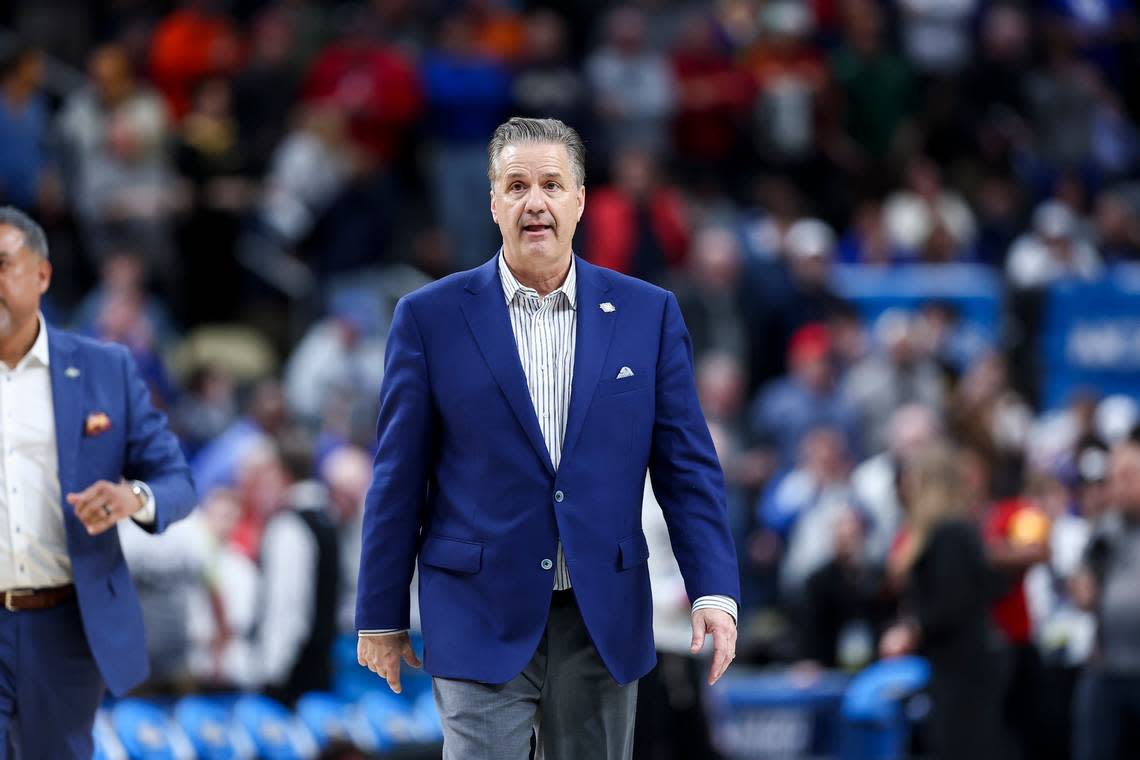The one area that most explains the Calipari-era decline in Kentucky men’s basketball
In the first nine NCAA tournaments in which John Calipari coached the Kentucky Wildcats, UK played 13 games against foes I would label as mid-major opponents.
Over those 13 contests, Kentucky held 12 of those mid-major opponents below 50% shooting, 11 of them below 40% and two below 30%.
It will not shock you that UK went 13-0 in those NCAA Tournament games against teams from conferences “down the food chain” from the so-called power leagues (the football Power Five plus the Big East).
Alas in Kentucky’s past three NCAA tourneys, the Wildcats have played two mid-major teams.
In the 2022 round of 64, the plucky Peacocks from Saint Peter’s shot 50.9% from the field and a scintillating 52.9% on 3-point attempts.
Last Thursday night in the NCAA round of 64, the Oakland Golden Grizzlies — led by the remarkable 10-for-20 3-point shooting by NCAA Division II expatriate Jack Gohlke — hit on 48.4% of their attempted treys.
Given those shooting percentages allowed, it’s profoundly easy to understand how the Wildcats have lost their past two NCAA Tournament games to mid-major foes, falling 85-79 in overtime to No. 15 seed Saint Peter’s in 2022 and 80-76 to No. 14 seed Oakland this year.
While there are myriad circumstances that have led to Kentucky’s competitive decline over the past four seasons of the Calipari coaching era, the single-biggest factor is the one illustrated by the numbers above.
The suffocating Kentucky defense that once enveloped the typically shorter players who dot mid-major rosters in NCAA Tournament play has gone missing in action.
“How do we get tougher? How do we get more physical?” Calipari asked after the loss to Oakland. “My teams, defensive and rebounding, have all (typically) been better than (the 2023-24 Cats).”

UK’s defensive problems are not just a phenomenon of NCAA Tournament contests against teams from one-bid leagues.
Over the past three seasons, Kentucky’s defensive decline can be illustrated via the adjusted defensive efficiency metric in the Pomeroy Ratings. In 2021-22, UK ranked 36th in NCAA Division I men’s basketball in adjusted defensive efficiency.
Last season — when UK went out of the NCAA tourney in the round of 32 but at least avoided a loss to a mid-major foe by being seeded too low (No. 6) to have to play one — the Wildcats dipped to No. 68 in defensive efficiency.
This season, with basketball still being played, the Cats stand a woeful 112th in adjusted defensive efficiency.
By way of contrast, of the four Calipari-coached Kentucky teams that reached the Final Four, one (2013-14) finished No. 32 in defensive efficiency, one ranked No. 16 (2010-11), one stood No. 7 (the 2011-12 NCAA championship team) and one finished No. 1 (the 2014-15 team went to the Final Four with a 38-0 record).
Contrary to the often expressed opinion that Calipari can’t change, the coach employed in 2023-24 the kind of perimeter-oriented, wide-open offensive attack for which many UK backers had been clamoring.
With other teams still playing, Kentucky currently stands No. 1 in the nation in 3-point percentage (40.88%); No. 2 in scoring (89.0 points a game); No. 4 in fast-break points (15.42 a game); and No. 8 in field-goal percentage (49.48%).
My firsthand memory of UK men’s basketball starts with Adolph Rupp’s final season (1971-72) as the Kentucky coach. In all that time, I don’t ever remember a Kentucky team that was as much fun to watch play offense as the 2023-24 Cats were.
“We’ve never been like this offensively,” Calipari said after the season-ending loss to Oakland. “I kind of like coaching the way I did this year.”
The rub, of course, is that, as fun as Kentucky was to watch this season, the Wildcats didn’t win any trophies.
For the sixth time in the past seven seasons, UK did not win the SEC regular-season title.
Not only did the Wildcats not win the SEC Tournament for the fifth straight year in which there was a completed tourney, the Cats for the second consecutive season did not even win a game at the event.
In the NCAA Tournament, not only did Kentucky fail to advance to a Final Four for the eighth straight year in which the event was held, UK failed to win a game in the Big Dance for the second time in three seasons.
Kentucky still has not made the second weekend in the NCAA tourney since an Elite Eight run in 2019.
Those accumulating failures to add to UK’s men’s basketball trophy case and bolster its program legacy are why we began this week with uncertainty about the future of Kentucky’s head coaching position.
If Calipari returns, his ultimate fate may depend on whether he can find a happy medium that combines elements of this past season’s wide-open offensive attack with a return to something closer to the stifling defensive prowess of his earlier — and far more successful — Kentucky teams.
What’s next for John Calipari? He might have answers on his future at Kentucky tonight.
What happens to Kentucky’s roster if John Calipari is gone? It won’t be good for the Cats.
Paying $33 million to buy out a basketball coach would be wrong thing for Kentucky to do
Five major questions for this Kentucky basketball offseason. Starting with John Calipari.
Lexington bar vents over Cats’ loss during ‘March Sadness’ by offering FireCal Shots
Where does Kentucky’s loss to Oakland rank among its notable NCAA Tournament defeats?
Why doesn’t Kentucky just pay the $33 million it would take to make John Calipari go away?
